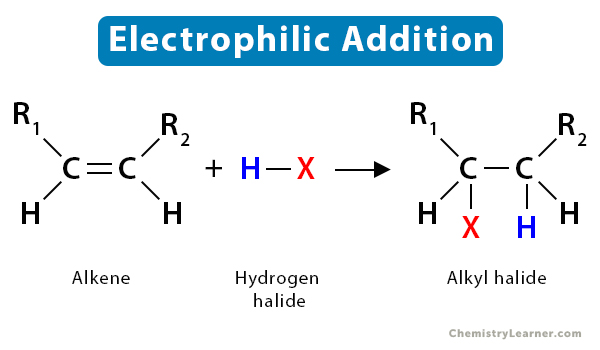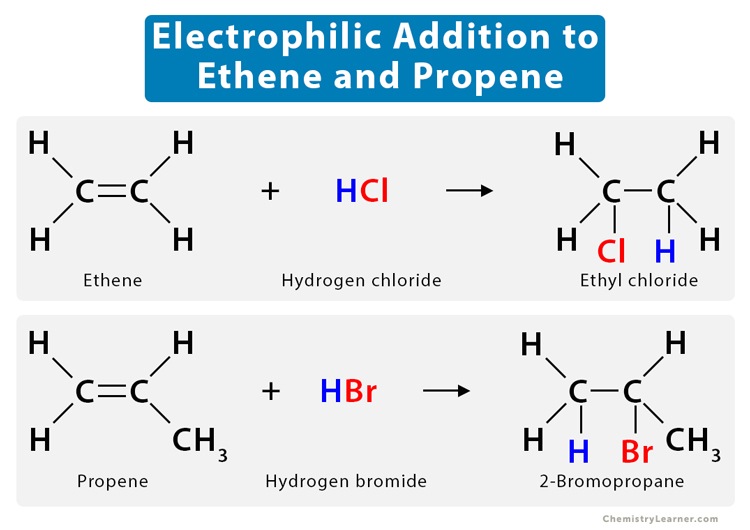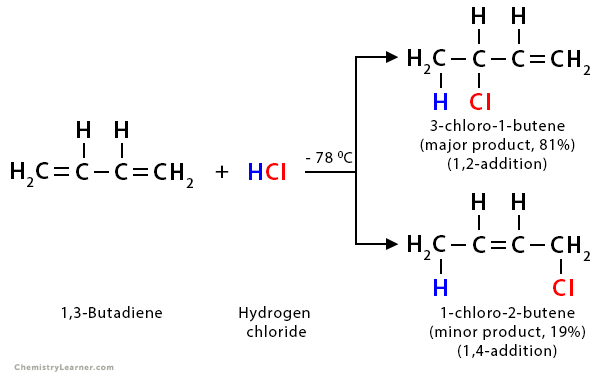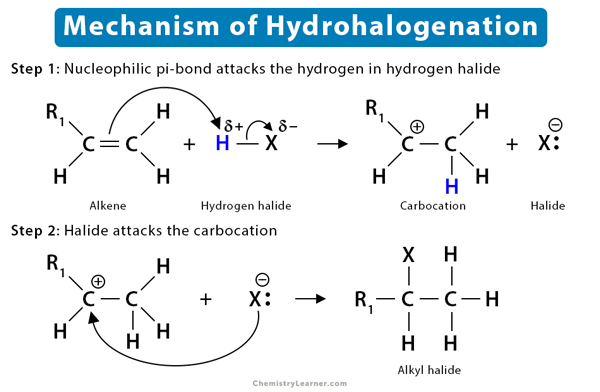Electrophilic Addition
What is Electrophilic Addition (1-5)
Electrophilic addition is a type of addition reaction where an electrophilic species combines with another compound to form a product without losing any atoms present in the reactants. As the name says, electrophiles are electron-loving species that accept electrons during the reaction. The pi bond (π bond) of unsaturated hydrocarbons gets broken during the reaction, and two new sigma bonds (σ bonds) are formed.
Alkenes are unsaturated compounds with at least one double bond between carbons. A double bond consists of a sigma bond and a pi bond. The carbon-carbon pi bond is relatively weak and exhibits high reactivity. The bond is formed by side-by-side overlapping. It is easily broken, and functional groups can be added to carbon. The pi electrons also make the carbons atom electron-rich and attract an electrophile. Thus, alkenes undergo electrophilic addition reactions very quickly.
List of Electrophilic Addition Reactions
General Reaction
Let us take hydrohalogenation and understand its general reaction. Here, an alkene R1CH=HCR2 reacts with a hydrogen halide HX, yielding an alkyl halide, R1CHBX-H2CR2.
The reaction is as follows:
R1CH=HCR2 + HX → R1CHBX-H2CR2
Order of Electrophilic Addition Reaction
The reaction rate of the electrophilic addition reaction increases as the alkene gets substituted. It means that as the number of alkyl groups attached to the carbon atoms at either end of the double bond gets increases, the rate of electrophilic addition reaction also goes up.
Therefore, the order of electrophilic addition reaction is:
Primary alkene < Secondary alkene < Tertiary alkene
Electrophilic Addition Reaction Examples (2-6)
Example 1: Reaction of Ethene (C2H4) with Hydrogen Chloride (HCl)
Ethene is a symmetrical alkene consisting of two carbon atoms. It reacts with hydrogen chloride in the presence of carbon tetrachloride (CCl4), producing ethyl chloride (CH2Cl – CH3).
CH2 = CH2 + HCl → CH2Cl – CH3
Example 2: Reaction of Propene (CH3CH=CH2) with Hydrogen Bromide (HBr)
Propene is an unsymmetrical alkene consisting of a three-carbon chain. With unsymmetrical alkene, there is a possibility of getting two different products during the reaction.
i) If the reaction follows Markovnikov’s Rule, then the reaction will be:
CH3CH=CH2 + HBr → CH3CHBrCH3 (major product, more stable)
ii) But, if the reaction does not follow Markovnikov’s Rule, then the product will be different:
CH3CH=CH2 + HBr → CH3CH2CH2Br (minor product, less stable)
Example 3: Bromination of Trans-2-butene (C4H8)
Trans-2-butene is a non-polar compound. When it reacts with bromine (Br2), it yields meso compounds, which means both the products are mirror images of each other.
Example 4: Reaction of 1,3-Butadiene (CH2=CH-CH=CH2) with HCl
1,3-Butadiene is a conjugated diene. Two electrophilic addition reactions could occur between 1,3-butadiene and HCl.
i) In the first reaction, the chlorine attaches to C-2 and the hydrogen to C-1. This reaction is called 1,2-addition, and its product is 1,2-adduct.
ii) In the second reaction, the hydrogen attaches to C-1, the double bond shifts from C-4 to C-3, and the chlorine atom get attached to C-4. Hence, this reaction is called 1,4-addition, yielding 1,4-adduct.
The regioselectivity of the overall reaction depends on the temperature. At low temperatures, the major product is 1,2-adduct. At high temperatures, it is 1,4-adduct.
Electrophilic Addition Mechanism (1-2)
In a general electrophilic addition reaction, the pi bond is removed and two new sigma bonds are created. The unsaturated hydrocarbon reacts with an electrophile to give a carbocation that then reacts with a nucleophile. It results in the simultaneous formation of the two σ bonds. Let us discuss the mechanism of the hydrohalogenation reaction.
Step 1: Breaking the Pi (π) Bond
In the first step, the nucleophilic pi bond of the alkene breaks down and attacks HX to grab its electrophilic H+. The pi electron must let go of the carbon atom that it is bound to, yielding an electron-deficient carbocation. The carbocation is a high-energy intermediate.
Step 2: Attack of the Halide
The nucleophilic halide ion (X–) attacks the electrophilic carbocation in this step. The halogen uses one of its lone electron pairs to attack the carbocation forming a sigma bond. In this context, stereochemistry is essential in determining the final product.
Markovnikov’s Rule and Regioselectivity
The mechanism of electrophilic addition reaction generally follows Markovnikov’s Rule. According to this rule, the carbon with fewer substitutions in a double bond of an unsymmetrical alkene will first grab the H+, producing a carbocation. In other words, the carbon with more hydrogen atoms attached to it will take the H+. So, the more substituted carbon atom of the double bond is converted to a stable carbocation, an electrophile. It means that the reaction is regioselective.
Anti-Markovnikov’s Rule
Sometimes, H+ may bind to a more substituted carbon rather than the least substituted carbon, following anti-Markovnikov’s Rule. This process is quite unusual, as carbocations formed in the majority during hydrohalogenation reactions tend to favor the more substituted carbon.
Stereochemistry
The nucleophile may attack the carbocation from the top or bottom of the pi bond. So, a mixture of syn and anti-products can be expected here.
Electrophilic and Nucleophilic Addition Reactions (7)
Similarities
- Both reactions are related to electron sharing.
- Both reactions result in covalent bonds.
Differences
| Features/Properties | Electrophilic Addition | Nucleophilic Addition |
|---|---|---|
| Definition | It is the process of adding an electrophile to the pi bond of an alkene. | It is the process of adding a nucleophile to either an electron-deficient species or a pi bond in a molecule. |
| Bond formation | An electrophile forms a sigma bond with a vinyl carbon atom in the double bond. | A nucleophile forms a sigma bond with a carbon atom in the substrate. |
| Accept or donate electron pair | Here, the added group accepts an electron pair. | Here, the added group donates an electron pair. |
FAQs
Ans. Benzene is electron-rich and attracts electron-deficient electrophiles. Therefore, it undergoes electrophilic substitution reactions very quickly.
Ans. Benzene is a planar stable molecule having delocalized electrons above and below the plane of the ring. It resists the addition reaction because it will lose its stability if it were.
Ans. Alkynes are usually less reactive than alkenes in electrophilic addition reactions because the π electrons are held more tightly in C≡C bonds than in C=C bonds.
References
- The Generalized Electrophilic Addition – Chem.libretexts.org
- Electrophilic Addition Reactions – Lasalle.edu
- Electrophilic Addition Reactions of Alkenes – Courses.lumenlearning.com
- Electrophilic Addition Reactions of Alkenes – Chem.libretexts.org
- Electrophilic addition to unsymmetrical alkenes – Chemguide.co.uk
- Electrophilic Additions to Conjugated Dienes – Chem.libretexts.org
- Additions- Electrophilic and Nucleophilic – Chem.libretexts.org









